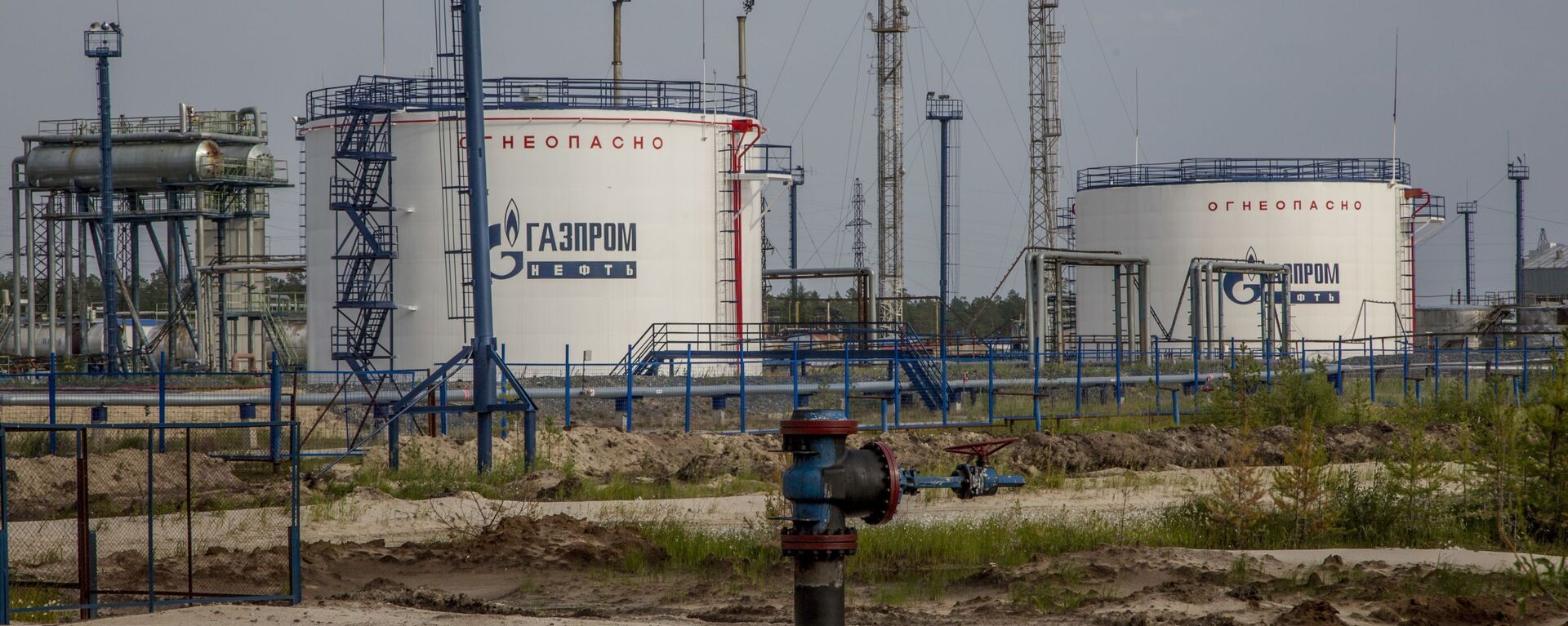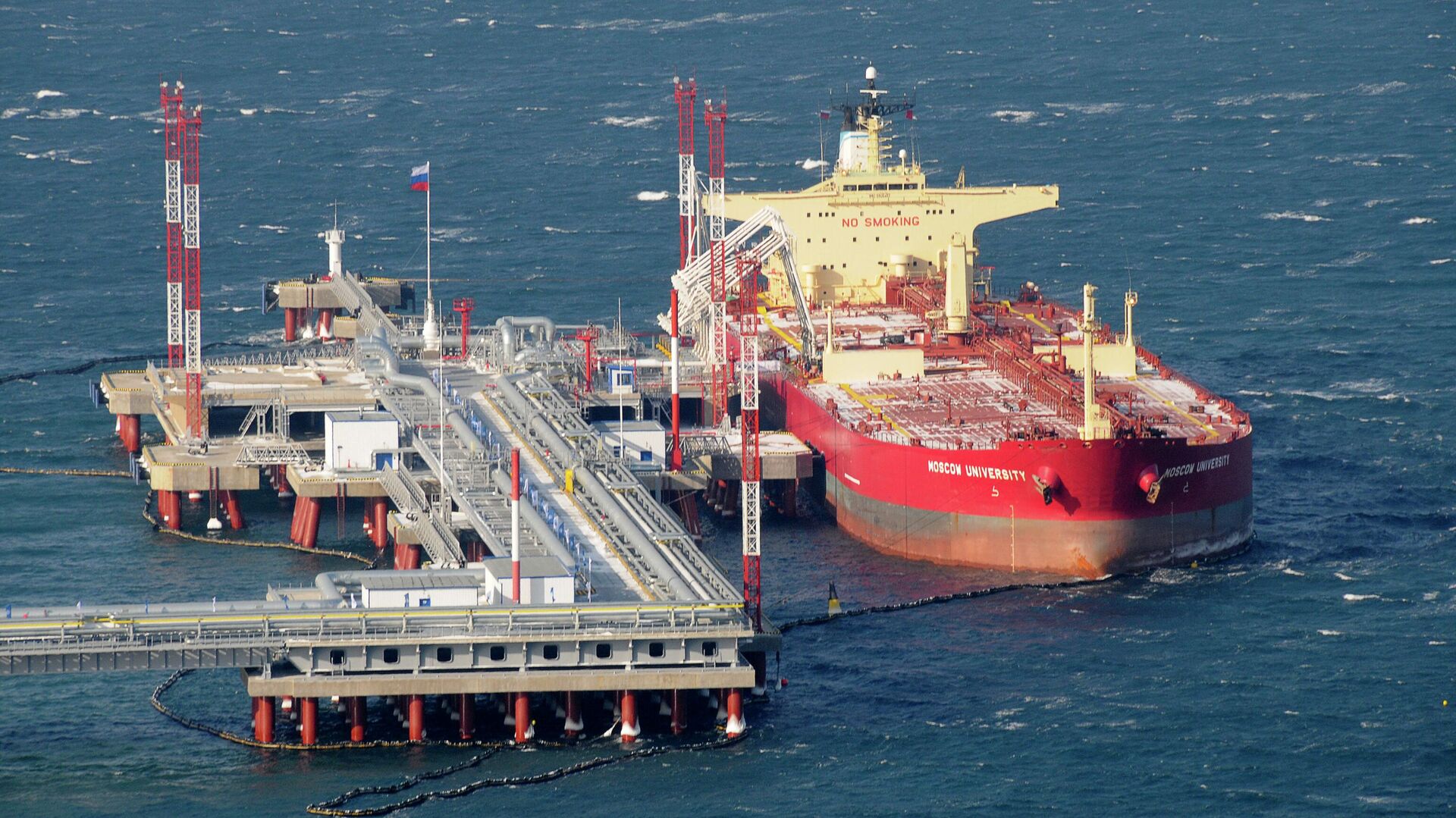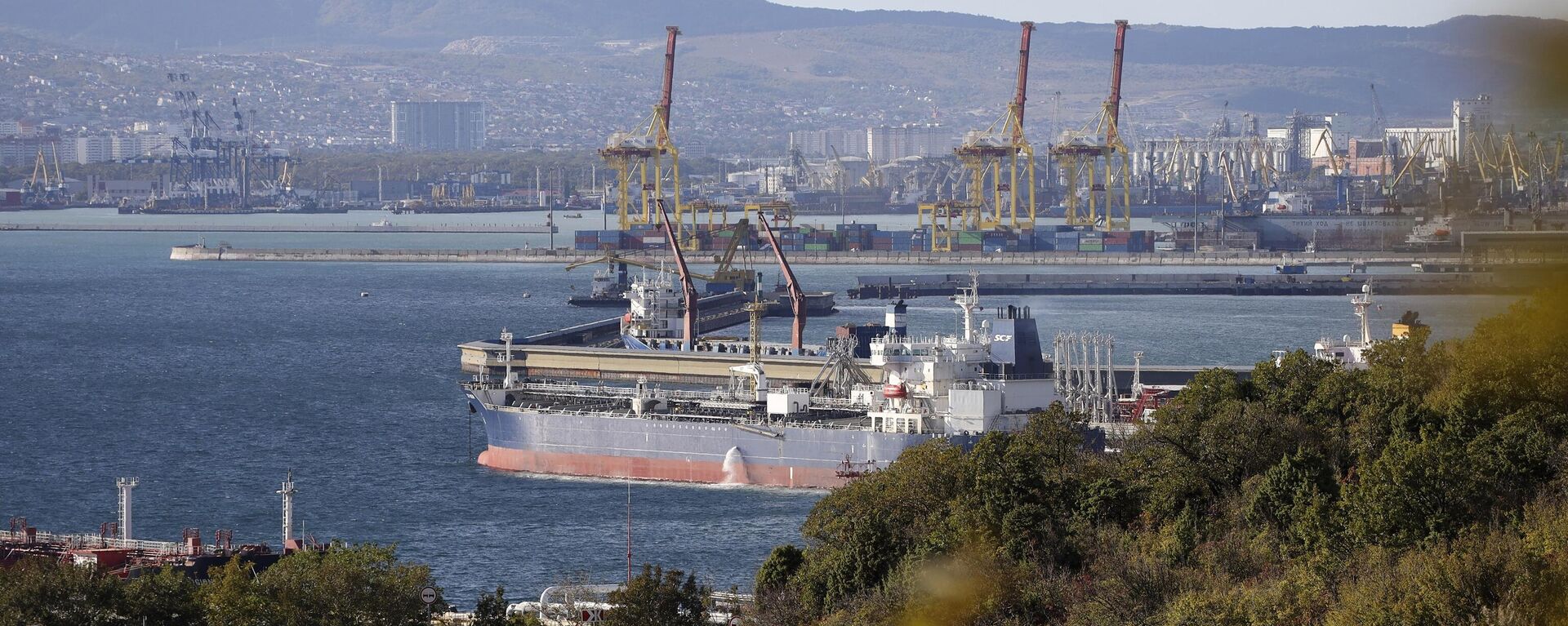https://sputnikglobe.com/20240314/peak-performance-russias-seaborne-crude-exports-hit-all-time-peak-in-2024-1117285969.html
Peak Performance: Russia's Seaborne Crude Exports Hit All-Time Peak in 2024
Peak Performance: Russia's Seaborne Crude Exports Hit All-Time Peak in 2024
Sputnik International
Despite geopolitical tensions, Western economic sanctions, including G7 price cap on Russian crude oil, and market uncertainties, Russia's crude export market has demonstrated resilience. It effectively navigates these challenges, shoring up robust export volumes and revenue streams.
2024-03-14T09:14+0000
2024-03-14T09:14+0000
2024-03-14T09:14+0000
business
russia
china
pacific
kremlin
g7
suez canal
sputnik
thierry bros
liquefied natural gas (lng)
https://cdn1.img.sputnikglobe.com/img/07e6/07/1b/1097841995_0:276:3083:2010_1920x0_80_0_0_f18d6375a88874bc7cf2fefbb3da4764.jpg
The volume of Russia’s seaborne crude exports peaked at its highest level in 2024, as shipments from a strategic Pacific terminal regained momentum following loading operations impeded by adverse weather conditions last week.Oil production spiked by 590,000 barrels daily in the week ending March 10. This upswing came after Russia renewed its commitment to the OPEC+ effort to mitigate a global market glut and bolster prices by curbing output.During the second quarter, the Kremlin intends to shift its focus from export targets to implementing a production cap. Despite international sanctions aimed at weakening the Russian economy, the gross value of crude shipments skyrocketed to $1.86 billion in seven days, marking the highest level since last October.Last week, 11 tankers left the Pacific port of Kozmino, one less than the record set the week before February 4. This is up by five from the previous week, which was slowed down by a storm with 40-mile-an-hour winds.Meanwhile, Sokol crude shipments from De Kastri are nearly back to normal, with shuttle tankers now delivering directly to Chinese refiners. But, shipments to Indian plants remain low, with 10.5 million barrels waiting in the East China Sea or docked near Chinese ports. A refinery near Pakistan's port of Karachi took delivery of the first Sokol cargo. This diversification in delivery destinations adds to the overall resilience of Russia’s crude export market.The gross value of Russia’s crude exports rose from an adjusted $1.53 billion the previous week. The average four-week income grew by roughly $50 million to $1.66 billion weekly.In the week to March 10, Russia’s seaborne crude flows climbed to 3.7 million barrels per day, the peak for 2024. The less erratic four-week average also jumped by around 50,000 barrels daily to 3.36 million barrels per day.Oil shipments to Russia's customers in Asia, even those without a clear destination, rose to 2.92 million barrels per day in the four weeks until March 10, an increase from the previous period's 2.89 million barrels. Each day, approximately 1.37 million barrels of crude oil were loaded onto ships bound for China. Beijing's ocean imports are supplemented by around 800,000 barrels daily from Russia via pipelines, directly or through Kazakhstan.Ships transport an average of 1.08 million barrels daily to destinations in India, and Chinese and Indian figures are expected to increase as vessels clarify their final discharge ports.Approximately 320,000 barrels a day are destined for Port Said or Suez in Egypt, or anticipated to be transferred off the South Korean port of Yeosu, typically bound for India or China. This includes Sokol crude cargoes stranded since mid-December. Another 100,000 barrels a day are on tankers without a clear destination, mainly originating from Russia's western ports and transiting the Suez Canal, potentially ending up in Turkiye.In the four weeks leading up to March 10, exports to Turkiye remained steady at approximately 417,000 barrels per day, reaching the highest level since the week ending December 5, and increasing from about 390,000 barrels a day as of February 25.Efforts to stifle Russian crude exports by the G7 to force Moscow to end its special military operation in Ukraine have largely been fruitless.In his speech at the Russian Energy Week plenary session last November, President Vladimir Putin stated that Russia reoriented oil supplies to new markets by increasing the tanker fleet and establishing insurance and reinsurance mechanisms. He mentioned that the government has prepared a plan for the development of export infrastructure, which will increase the supply of Russian oil to the countries of the Asia-Pacific region, Africa, and Latin America.Experts believe that Asia will experience enhanced industrialization due to the high rate of Russian crude imports, while the EU faces deindustrialization.Dr. Mamdouh G. Salameh, an international oil economist and global energy expert, told Sputnik that Russia "neither needs Western shipping nor insurance for its oil cargoes...If more tankers are needed, it could avail itself to Chinese, Indian, and other Asian tankers, with customers insuring their cargoes given the preferential oil price they are receiving from Russia."
https://sputnikglobe.com/20230712/russian-crude-oil-on-verge-of-busting-western-sanctions-price-cap-1111833289.html
https://sputnikglobe.com/20221205/oil-prices-surge-as-price-cap--embargo-on-russian-crude-enter-force-1105039725.html
russia
china
pacific
Sputnik International
feedback@sputniknews.com
+74956456601
MIA „Rossiya Segodnya“
2024
Chimauchem Nwosu
https://cdn1.img.sputnikglobe.com/img/07e7/09/01/1113046371_0:99:1536:1635_100x100_80_0_0_9c5c627283eca931c39fe4852bbb301c.jpg
Chimauchem Nwosu
https://cdn1.img.sputnikglobe.com/img/07e7/09/01/1113046371_0:99:1536:1635_100x100_80_0_0_9c5c627283eca931c39fe4852bbb301c.jpg
News
en_EN
Sputnik International
feedback@sputniknews.com
+74956456601
MIA „Rossiya Segodnya“
Sputnik International
feedback@sputniknews.com
+74956456601
MIA „Rossiya Segodnya“
Chimauchem Nwosu
https://cdn1.img.sputnikglobe.com/img/07e7/09/01/1113046371_0:99:1536:1635_100x100_80_0_0_9c5c627283eca931c39fe4852bbb301c.jpg
russian crude oil, crude oil, russian crude shipments, russia’s seaborne crude exports, opec+ production cuts.
russian crude oil, crude oil, russian crude shipments, russia’s seaborne crude exports, opec+ production cuts.
Peak Performance: Russia's Seaborne Crude Exports Hit All-Time Peak in 2024
Despite geopolitical tensions, Western economic sanctions, including the G7 price cap on Russian crude oil, and market uncertainties, Russia's crude export market has demonstrated resilience, effectively navigating these challenges and shoring up robust export volumes and revenue streams.
The volume of Russia’s seaborne crude exports peaked at its highest level in 2024, as shipments from a strategic Pacific terminal regained momentum following loading operations impeded by adverse weather conditions last week.
Oil production spiked by 590,000 barrels daily in the week ending March 10. This upswing came after Russia renewed its commitment to the OPEC+ effort to mitigate a global market glut and bolster prices by curbing output.
During the second quarter, the Kremlin intends to shift its focus from export targets to implementing a production cap. Despite international sanctions aimed at weakening the Russian economy, the gross value of crude shipments skyrocketed to $1.86 billion in seven days, marking the highest level since last October.
Last week, 11 tankers left the Pacific port of Kozmino, one less than the record set the week before February 4. This is up by five from the previous week, which was slowed down by a storm with 40-mile-an-hour winds.
Meanwhile, Sokol crude shipments from De Kastri are nearly back to normal, with shuttle tankers now delivering directly to Chinese refiners. But, shipments to Indian plants remain low, with 10.5 million barrels waiting in the East China Sea or docked near Chinese ports. A refinery near Pakistan's port of Karachi took delivery of the first Sokol cargo. This diversification in delivery destinations adds to the overall resilience of Russia’s crude export market.
The gross value of Russia’s crude exports rose from an adjusted $1.53 billion the previous week. The average four-week income grew by roughly $50 million to $1.66 billion weekly.
In the week to March 10, Russia’s seaborne crude flows climbed to 3.7 million barrels per day, the peak for 2024. The less erratic four-week average also jumped by around 50,000 barrels daily to 3.36 million barrels per day.
Oil shipments to Russia's customers in Asia, even those without a clear destination, rose to 2.92 million barrels per day in the four weeks until March 10, an increase from the previous period's 2.89 million barrels. Each day, approximately 1.37 million barrels of crude oil were loaded onto ships bound for China. Beijing's ocean imports are supplemented by around 800,000 barrels daily from Russia via pipelines, directly or through Kazakhstan.
Ships transport an average of
1.08 million barrels daily to destinations in India, and Chinese and Indian figures are expected to increase as vessels clarify their final discharge ports.

5 December 2022, 06:50 GMT
Approximately 320,000 barrels a day are destined for Port Said or Suez in Egypt, or anticipated to be transferred off the South Korean port of Yeosu, typically bound for India or China. This includes Sokol crude cargoes stranded since mid-December. Another 100,000 barrels a day are on tankers without a clear destination, mainly originating from Russia's western ports and transiting the Suez Canal, potentially ending up in Turkiye.
In the four weeks leading up to March 10, exports to Turkiye remained steady at approximately 417,000 barrels per day, reaching the highest level since the week ending December 5, and increasing from about 390,000 barrels a day as of February 25.
Efforts to stifle Russian crude exports by the G7 to force Moscow to end its special military operation in Ukraine have largely been fruitless.
In his speech at the Russian Energy Week plenary session last November, President Vladimir Putin stated that Russia reoriented oil supplies to new markets by increasing the tanker fleet and establishing insurance and reinsurance mechanisms. He mentioned that the government has prepared a plan for the development of export infrastructure, which will increase the supply of Russian oil to the countries of the Asia-Pacific region, Africa, and Latin America.
“Thanks to the actions of companies and authorities, the tanker fleet has been increased, new payment mechanisms, insurance and reinsurance of our cargo have been created. As a result, in a short time it was possible to switch oil supplies to the fast-growing and promising markets of the world - the South and the East,” Vladimir Putin, told Russian news outlets.
Experts believe that Asia will experience enhanced industrialization due to the high rate of Russian crude imports, while the EU faces deindustrialization.
Dr. Mamdouh G. Salameh, an international oil economist and global energy expert, told Sputnik that Russia "neither needs Western shipping nor insurance for its oil cargoes...If more tankers are needed, it could avail itself to Chinese, Indian, and other Asian tankers, with customers insuring their cargoes given the preferential oil price they are receiving from Russia."





